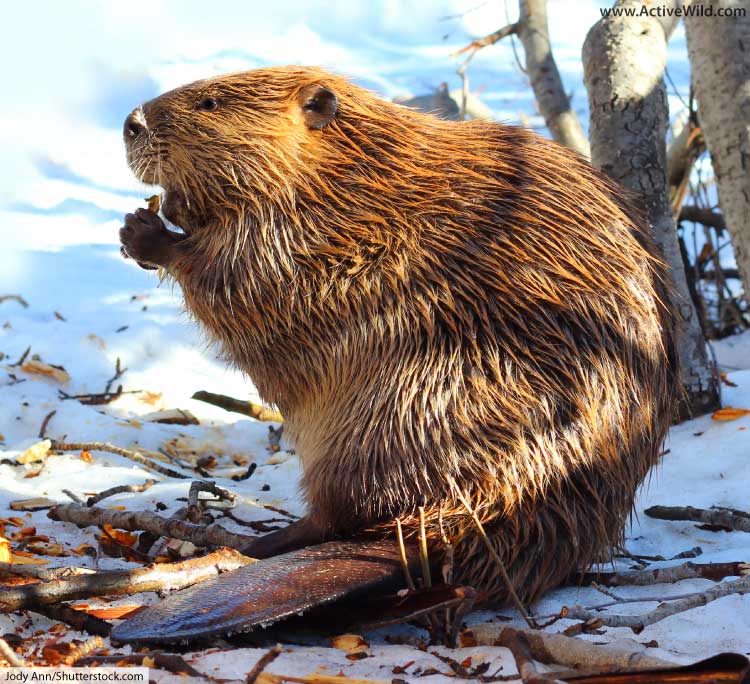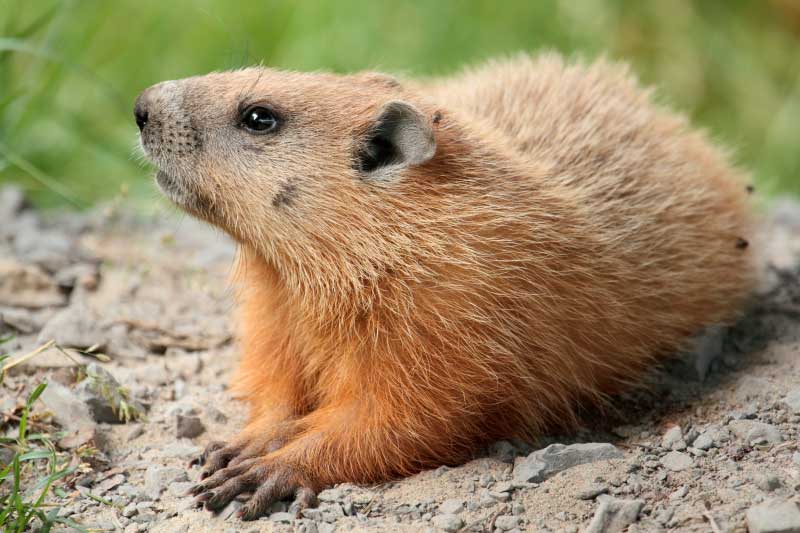The groundhog – also known as a woodchuck – is a burrowing rodent in the squirrel family Sciuridae. It is found in grasslands and forests of the USA and Canada, and is unusual among marmots for living in lowland areas.
A groundhog named Punxsutawney Phil is central to the traditional Groundhog Day celebrations held each year on the 2nd of February in Punxsutawney, Pennsylvania.
It’s said that if Phil emerges from his burrow and is able to see his shadow, then there will be six more weeks of winter. If Phil cannot see his shadow, then spring will arrive early!
Sadly, this year (2021) Phil did see his shadow!
On this page you’ll find groundhog facts, pictures and in-depth information on the species…
Groundhog Facts: Page Index
- Groundhog Facts At A Glance
- Groundhog Vs Woodchuck
- How To Recognize A Groundhog
- Groundhog Vs Beaver
- Animals Related To The Groundhog
- Marmots
- Habitat and Ecology
- What Do Groundhogs Eat?
- Groundhog Predators
- Do Groundhogs Hibernate?
- Groundhog Burrows
- Groundhog Life Cycle
- Further Reading
Groundhog Facts At A Glance

- Scientific name: Marmota monax
- Type of Animal: Mammal. Rodent.
- Animal Family: Sciuridae (the squirrel family).
- Where Found: Forests & Grasslands in the USA and Canada
- Length (head and body): 14" to 20" (35.5 to 51 cm)
- Length (tail): 4.5" to 6.5" (11.5 to 16.5 cm)
- Weight: 7 to 11 lb. (3.2 to 5 kg)
- Conservation Status: Least Concern
Groundhog Vs Woodchuck
Woodchuck, whistlepig, and moonack are all common names for the same animal: the groundhog (Marmota monax).
Despite its name, the woodchuck / groundhog doesn’t actually chuck wood! The name comes from wuchak, the animal’s Algonquian name.
How To Recognize A Groundhog

The groundhog is one of the largest members of the marmot genus, Marmota. As a group, marmots are heavyset, ground-dwelling squirrels that mainly live in mountainous areas of Europe, Asia, and North America.
Adult groundhogs range in size from 7 to 11lb (3.2 to 5 kg). Their weight fluctuates over the course of the year: they are at their lightest in spiring when they emerge from hibernation. Then, in summer and fall, they fatten up for winter and can almost double their weight in just a few months.
Groundhogs are distinctive animals – in most places where they occur, they are the only local marmot species and therefore unlikely to be confused for anything else.
Despite being members of the squirrel family, groundhogs don’t particularly look like the typical suburban tree squirrels. They are much heavier and rounder, with a stubbier face and shorter tail.
Groundhogs are mostly active during the day.
Groundhog Vs Beaver

Groundhogs may superficially resemble beavers, having the same stocky body proportions and short, broad snout. But they lack their fellow rodents’ distinctive flat tails and live on dry land, not in water as beavers do. A groundhog is also much smaller than a beaver.
Animals Related To The Groundhog
Groundhogs’ closest relatives are their fellow marmots (genus Marmota). North America has several other marmot species, such as the Olympic marmot and Vancouver Island marmot of the Pacific Northwest, the Alaska Marmot of Alaska, and the yellow-bellied marmot of the Rocky Mountains.

Surprisingly, groundhogs don’t seem to be particularly close relatives of the other North American marmots. It seems like the groundhog might actually be closer to Asian species such as the Himalayan marmot and the bobak marmot of central Asia.
If true, this would be something of a mystery for biogeography – how did this Asian-derived ground squirrel become so widespread in North America?
Marmots
The marmot genus belongs to the squirrel family (Sciuridae), which in turn is part of the rodent order (Rodentia).
Marmots diverged from other squirrels around 10 million years ago, at a time when many mammal families (including our own) were rapidly diversifying.
The first marmots were cold-weather specialists: they developed large, stocky bodies to retain heat and developed the ability to hibernate underground to keep themselves safe from dangerously cold winters.
During the various Ice Ages of the last couple of million years, marmots could survive in places where other squirrels could not. When the climate cooled, they would spread into new areas; when the climate warmed, they would retreat to mountain tops, northern latitudes, and other enclaves of cold weather.
Most marmots are highland animals, specialized for life among the peaks in places like the Alps and the Rockies. But the groundhog is different: it prefers lowland habitats in places like the Great Lakes region.
Despite living at low elevations, where the weather tends to be warmer, groundhogs still make use of their cold-weather adaptations. They tend to live in places where the temperature varies widely with the seasons: the American Midwest, for example, is famous for its warm summers and bitterly cold winters.
Curiously, there is another marmot species that also lives in highly seasonal habitats at low elevation: the Asian bobak marmot. Like the groundhog, it avoids the mountains and is found on the low-lying steppes and grasslands of Kazakhstan. This is one of the same animals which, as we saw earlier, may be one of the groundhog’s close genetic relatives.
The similarity in habitat lends support to the idea that groundhogs are relatives of the Asian marmots, but it doesn’t explain how they ended up in North America!
Groundhog Habitat and Ecology

Groundhogs are found across Canada and the eastern U.S. Their range extends as far south as Tennessee and the Carolinas, but they are not found in Texas or the Deep South. They can be found in Canada from Newfoundland to the Yukon, but are mostly absent from the Rocky Mountains.
Groundhogs can adapt to a variety of habitats, from grasslands to forests to agricultural fields, but they are most at home in sparse, open woodland – exactly the kind of environment you often find in the suburbs of American cities.
The groundhog is a familiar backyard rodent across much of Canada and the eastern U.S., where it has a (not undeserved) reputation as a garden pest. It is a voracious eater in summer and fall, and can dig an elaborate network of tunnels that can undermine a garden and potentially damage a shed or driveway.
What Do Groundhogs Eat?
Groundhogs mainly eat flowers, berries, and herbs like wild lettuce. When they’re fattening up for hibernation, they can eat as much as 20% of their body weight in a single day. For a human, that would be like eating a large pizza every hour from sunrise to sunset.
Gardens and farms provide abundant food resources for groundhogs, which is why they’ve come to be known as household pests - a few hungry groundhogs can easily wipe out a family vegetable garden.
To keep the garden safe without harming any groundhogs, the Humane Society recommends dumping used cat litter into the groundhog’s burrow. Once their burrow is soiled, the groundhogs will find another place to nest.

Groundhog Predators
Adult groundhogs are large enough that they have few predators. Hawks, foxes, and raccoons will take a groundhog while it’s young, but once it reaches full size it’s difficult to take down.
Wolves and mountain lions could eat groundhogs, but these animals have become extremely rare as humans destroy more and more of their habitat.
That may be one reason why groundhogs are so common in suburbs and agricultural areas: living near humans keeps them safe from predators. There is one major predator, though, that’s just as comfortable around humans as the groundhog: the coyote.
Do Groundhogs Hibernate?
Like all marmots, groundhogs hibernate during the winter. Marmot hibernation is considered “true” or “deep” hibernation because its effect on the body is so extreme.
During hibernation, a groundhog will not eat, drink, or pass waste – it subsists entirely on the energy stored in its fat tissue.
To make the energy last longer, the animal’s metabolism slows to almost nothing – the heart beats just a few times per minute, body temperature drops to just a few degrees above freezing, and the animal breathes only once every six minutes.
Groundhogs can remain in hibernation for several months, typically from October through March.
Groundhog Burrows
Groundhog dens are elaborate structures, up to 60 feet long, with multiple chambers. The main chamber, the nest chamber, is lined with soft bedding made from dead vegetation. They also have an excrement chamber – basically an underground latrine – and a separate chamber for hibernation. A groundhog den will have at least two entrances so that the residents have a way to escape from predators.
Many ground squirrels and marmots construct elaborate dens to house large social groups – prairie dogs, for example, build huge burrows known as “towns.” But the groundhog is unusual in that it appears to be solitary. Baby groundhogs leave the nest when they’re a few months old and may never see another individual except to reproduce.
Although they live alone, adult groundhogs do communicate with each other. They use long, high-pitched alarm calls to warn each other about predators, and it’s this warning call that gives them the name “whistlepig.”
Although they live underground, marmots are capable of climbing trees when they want to escape a predator or steal food from a backyard bird feeder. They are bulky and not particularly nimble, though, so they tend to be awkward climbers.
Groundhog Life Cycle
Groundhogs mate after coming out of hibernation, typically around March. That way their young will be born in mid-spring, when food is abundant. A male and female will share a single burrow during the female’s pregnancy, but once the young are born the male leaves the burrow.
Offspring disperse from the nest in late summer, when it’s time to fatten up for the winter. This may explain why groundhogs aren’t social: in order for each individual to get enough food to survive the winter, they may need to spread out to avoid competing with one another.
Further Reading
Enjoyed the groundhog facts on this page? Find out more about the animal kingdom on the following pages:
- Find out more about the official groundhog day in Punxsutawney
- North American Animals List. Pictures & Facts On The Iconic Animals Of North America, With FREE Printable Worksheet
- North American Porcupine Facts: Discover North America’s Second-Largest Rodent
- Flying Squirrels Facts: Meet The Gliding Rodents Of North America!
- Rodent Facts: The Ultimate Guide To The Order Rodentia



I live in Birmingham, AL and thought I saw a ground hog today. Is it possible for them to be this far south? If it wasn’t a ground hog, what do you guess it might have been? We live up on a mountain in a suburban development.
I love your pictures of animals. I love animals. My, My It’s a beautiful sight when you’re walking outdoors.
2 fact check notes from a life-long Punxsy area resident.
I believe the GH is diurnal vs. nocturnal. Highly visible in daytime; never visible on nighttime trailcam
Also, winter continues when Phil DOES see his shadow. Can be traced to European origin of legend. Warming trends indicating spring is on the way develop from winds and cloudiness blowing in from Atlantic over Gulf Stream. Conversely, winds coming down from Siberia on cold and clear days generally lead to more winter weather.
Hi,
Many thanks for your comment. The errors crept in when we added a new introduction to the page.
The introduction has now been edited as a result of your feedback.
We really appreciate your taking the time to get in touch.
Regards,
The Active Wild Team
When I heard the old-timer name, “Whistle-pig” – I started whistling at the one I see on my daily walks. They actually stop and stare at you!
… There must be something in those old names, then! 🙂
Thanks for letting us know!
Regards,
The Active Wild Team